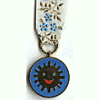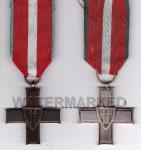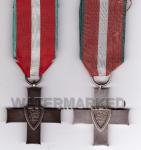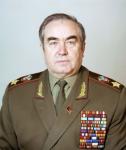-
Posts
684 -
Joined
-
Last visited
-
Days Won
3
Content Type
Profiles
Forums
Blogs
Gallery
Events
Store
Everything posted by Lukasz Gaszewski
-
Thank you JapanX and Ferdinand for response. Boris Tkach would be more logical, as he had served in Afghanistan, although we shall not know until we see what was inside the application for his order. At least we know that the Order of Suvorov went to marshal Sergey Sokolov, as he was the only recipient in 1982. BTW: I wonder if he ever set foot on the Afghan soil.
-
OK, I am not sure if it is going to develop, but let's try. I am opening a new Soviet Quiz for 2014. As far as I could find, there was no quiz in 2013, so maybe this year... Let me put forward the first question. On the photo below you can see a group of individuals who held very important military (and not only) posts in the 1980s. 1. Identify all identifiable ones (including rank and country they were from). 2. What were the highest posts they held? And an additional question for experts: 3. Try to estimate when this photo was taken. Enjoy and good luck!
-
Gents, it is known that ribbon bars were never officially intoduced in the army of the Russian Empire up to its end and the first bars appeared only in the Red Army as late as in 1943. My question is if somebody knows if there ever were any unofficially worn ribbon bars, either in the Russian Army or in any of the forces related to it (Czechoslovak Legion, Polish Corps in Russia, "white" armies during the Civil War etc.) Perhaps someone has seen photos or even original bars. I will owe for any information.
-
Now, I must say I feel slightly lost... The dimensions match exactly these of the original items... Reproductions are usually slightly bigger and, first of all, much thicker. When I first had an original cross in hand I was surprised how thin it was. But this poor finish... Perhaps your cross leaked out of the mint before it was properly smoothed up. Well, anyway, you can believe it is the original...
-

Imperial Russia Imperial ribbons chart
Lukasz Gaszewski replied to GeorgeCL's topic in Russia: Imperial
There is another server. The current address is: http://www.medals.pl/ru/ru1.htm -
A friend of mine will be flying to Beirut, Lebanon in about two weeks. Any idea of where to buy medals while there and if it is difficult to get them out of there? Thanks for any info.
-
OK, to make the things clear, and as far as I understand it, a fake is an item sold as the original while it is not; any other non-original one is just a copy. Some collectors insist that even original mint items should be called copies, if they were not awarded - in this sense even genuine mint items can be copies. I do not want to disappoint you, still the cross on the photos does not look original. And I am not even talking about the details, I am talking about the finish which is very poor - uneven edges and scratches. Also the welding is crude and careless. If it was a mint item, it would certainly not pass quality control. To be sure, would you provide the exact measures of the cross, best up to half milimeter: overall arm length with and without finials, arm width and, very important, its thickness. A photo of the side would certainly be a bonus. To compare, here is a photo of an original (left) and a privately made copy (right) - sorry I have only a watermarked photo. Although the resolution is not too big, the differences are clearly seen. To make you a bit happier, let me say that your Cross of Valor, Greater Poland Uprising Cross and Partisan Cross all look original indeed.
-
A really tasty photo of the Marshal and his ribbons, Uwe. Thank you, I have never seen it before. I have had a hard time searching through the Net, and I think I have got it! I have found an older photo of Kulikov, dated ca. 1980. The photo is in colour and the ribbons can be seen pretty well. The ribbon most interesting to us is down in the 10th row (red marked). It can be seen that the edges are green, so it looks like the DDR Medal for Merit for Border Troops in silver. So, Michael and Uwe, you were both right - Kulikov did not have the Order of Blücher. BTW: I have no idea what made Kulikov value just that medal so high to put it among the orders. It seems that the Marshal (or perhaps his tailor) was quite careless about medals. On the same photo the ribbons of medals commemorating 30th and 40th anniversary of Soviet Forces are reversed, so are the Order of Scharnhorst and Order of Merit for People and Fatherland. Regards - Lukasz
-
The reason why I am asking is that I recently found a photo, which I date (based on the medals) on ca. 1986, depicting Polish gen. Jaruzelski (in a suit) greeting Soviet marshal Viktor Kulikov. On the carpet of ribbons on Kulikov's chest there are two groups of DDR's ribbons. The questioned ribbon (marked with a red oval) is in the upper group, between the Order of Scharnhorst and Order of Merit for People and Fatherland. I initially thought it was the silver Medal for Merit to NVA, but a gold one (marked blue) is clearly seen in the other DDR group, four rows below. Logically, if the Marshal had both, they should be grouped together and the gold medal should precede the silver. The ribbons are too small to see the details, but looking closer, it seems that the mysterious ribbon is violet rather than red, with a white stripe in the centre. The exact color of the side stripes is unfortunately difficult to determine. Considering its placement among other DDR orders rather than medals, is it possible that it could be the silver class of the Order of Blücher? If not, what else can it be?
-
Does somebody know if the DDR's Order of Blücher was ever awarded to someone? I know it was considered to be a "war order," not to be bestowed in peacetime, and although established as early as in 1965, its existence was kept secret and it was not even listed on any order of precedence list until the very end of DDR. Still, perhaps someone has a record of someone being awarded.
-
Hard to believe... Rest in peace Rick. This forum will never be the same without you. We will miss you a lot.
-

The Arctic Star
Lukasz Gaszewski replied to Megan's topic in Great Britain: Orders, Gallantry, Campaign Medals
A bit late, but thank you Megan for sharing the news, although issuing a medal like this almost 70 years after the war is certainly controversial. BTW: does anybody know the place of the new star in the order of precedence - I could not find it anywhere: right behind the Atlantic Star or somewhere else? Also which other stars can it go together with and which it cannot? And finally, which stars can the "BOMBER COMMAND" clasp be attached to? -
Yes, in all sources I have his surname is spelled SILVESTER, so I believe it is correct. Also in all the sources he is referred to as Col. Silvester, without the first name. Still I think Ferdinand could be the name. In 1938 the colonel of the General Staff Ferdinand Silvester was the chief of staff of the Czechoslovak 3rd Army and It could be him indeed. As of now I have not been able fo find his name anywhere else.
-
Ian, it is a fantastic collection that you have found. These phots are real gems indeed! The gentleman who was the Latvian military attache in Warsaw is Lt. Col. Alexandre Winter. Unfortunately I am not able to find any further information about him on the Net. The name seems too common. It is also possible that it is slightly misspelled. I will go on trying to find out the other folks. Lukasz
-
The signature on the photo reads "J.J. Axentowicz". Capt. Jan Axentowicz was a graduate of the French École Supérieure de Guerre of 1933. On the above photo, dated "7 XI 36" he is already a Major. He indeed accompanied foreign officers during their visits to Poland. He was a liason officed during Gen. Gamelin's visit in 1936. In 1939 LTC Jan Axentowicz held the post of the chief of staff of the 24th Infantry Division, yet I am not sure if that was the same person. Ian, can I have a look at the other photos? Perhaps I will be able to tell you more.
-

Poland 1920s Polish medal - original or fake?
Lukasz Gaszewski replied to Leclerc's topic in Central & Eastern European States
Can you put both side by side? -

Poland 1920s Polish medal - original or fake?
Lukasz Gaszewski replied to Leclerc's topic in Central & Eastern European States
Lt. Wilhelm Jan Starck commanded the 2nd Assault Company during the defence of the city of Lwow in the Polish-Ukrainian conflict of 1918-1919. The cross was awarded afterwards to former company members. At first sight the cross on the photo seems to be a modern restrike. Quite cheap and easy to get. Still, if you posted the cross in a better resolution (both sides), this could help. Are there any manufacturer's signs on it? -
To me it is visually OK. It has the form of a cross (quite rare in the U.S. award system) to go with equivalent crosses of the other services. The seldom encountered form of cross urdee makes it distinctive and easy to recognize at the first glance. Also the ribbon, navy blue with CG colors seems logical and well-chosen. If I was the designer, the only change I would probably change, would be not using color enamel. BTW, I wonder who designed it. I visited TIOH website, but did not find anything about the cross there. What is questionable is the necessity of such an award and I absolutely agree with Paul in this aspect. IMHO, it was established to fill the gap, as CG was the only service that did not have a combat decoration of this rank. Doc is right to say it can potentially be awarded to civilians as well, yet I am sure the conferment will be restricted to U.S. military only, Anyway, I do not think it will be welcomed very warmly, simply because the Navy Cross was a more prestigious award. And I am serious to say that the establishment of the Coast Guard MoH would be the next logical step to make the award systems of all services similar.
-
Found this on the Net and was quite surprised it had not been on the forum yet. I found it on someone's blog (ODM unrelated) with just this caption and no other information: I managed to find the legal act of 2010 that introduced it (Congress Public Laws 112-131). The excerpt regarding the cross reads as follows: The same act allows awarding the Silver Star when CG is not operating under the Dept. of the Navy and extends the conferment of the Distinguished Flying Cross to CG (for some reason it does not include the Bronze Star and Air Medal). I was unable to determine if the act is already in force or not. I personally can hardly see the use of a cross like this. As CG is normally not involved in combat operations and the new cross is a combat award, it will be one of the rarest U.S. awards, particularly that it can be conferred only when the Coast Guard is not operating under the Department of the Navy. Of course, as a medal researcher and collector I am happy to see any new medal established. Now it is probably the time for the Coast Guard Medal of Honor as well! If it is ever established, remember it was me who first put forward the proposal :D :D
-
JapanX and Frank: I do agree that the prestige of the Order for Merit, especially in the lower classes is not as big as that of the Order of Lenin had. Yet, if we assume that the Order of Lenin was the equivalent of the Order for Merit 1st Class (not to mention that of St. Andrew), how should we treat the second, third, fourth and further awards? While comparing the possible equivalence of particular orders I had a look at the statistics of awards. The results are as follows (with Wiki as the source): Order of Lenin: 431,418 awards (incl. multiple ones) in 61 years (1930-1991) gives ca. 7072 awards per year. Order for Merit 4th class: over 3000 awards in 18 years (1994-2012) gives ca. 167 awards per year. Order for Merit - all classes (if we consider upper classes as multiple awards): 3930 awards in 18 years gives ca. 218 awards per year. Note that when established in 1994 the Order of Merit was the country's top order. As we can see, the Order for Merit is awarded much less frequently than the Order of Lenin was. I realize the comparison is not this simple as there are many factors that are difficult to compare. I just wanted to give a hint. What regards HSL and Order of St. Andrew: Gold star of the Hero of Socialist Labour: 20,812 awards in 53 years (1938-1991) gives ca. 393 awards per year. Order of St. Andrew: 15 awards in 14 years (1938-1991) gives ca. 1 awards per year (actually much less that the gold star of HSL).
-
I originally did not intend to enter the discussion, still in general perception it is the Order "For Merit to the Fartheland" rather than the Order of St. Andrew that is perceived as the equivalent of the Order of Lenin. Note that the Order of Lenin could be awarded multiple times (with the record holders with 12 and 11 awards respectively), whereas the Order for Merit is a four-class award, which can be bestowed once in each class. Thus the fourth class is seen as the counterpart of the Order of Lenin awarded for the first time, the third class as the OL awarded for the 2nd time and so on. The Order for Merit was thought as a strange melange of the imperial Order of St. Alexander Nevsky (insignia) and of St. Vladimir (4-class division and scope of merit). If the comparison of the Order of St. Andrew to any Soviet award ever made sense, I would vote for the gold star of the Hero of Socialist Labour , with the notable difference that St. Andrew can be awarded to other countries' nationals (usually heads of state). The Order of St. George is a different category, as it is a combat award, conferred for acts of valour or commanding military units. I would compare it therefore to the combined British Order of the Bath and DSO.
-

South Carolina establishes Medal of Valor Act
Lukasz Gaszewski replied to JPL's topic in United States of America
Some other states have already introduced medals like that. It would be nice to know some details as of what the medal is going to look like.








